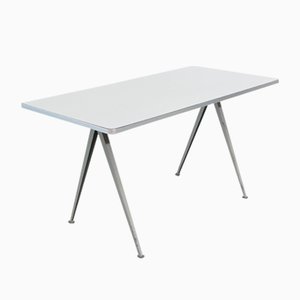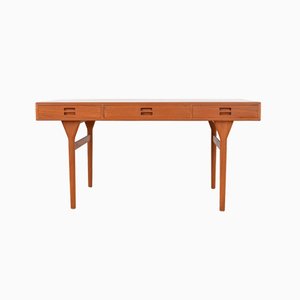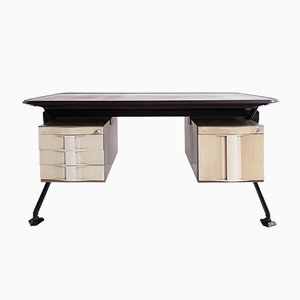A look at the best vintage desks and variations on the midcentury modernist style
Mid-Mod at Work
Obsession with midcentury modernism interior design has been kicking around for two decades, and these days everyone has an opinion: Is it past its prime? Should it be? While it is true that trained eyes can pick a midcentury piece from any line-up, these sorts of conversations sometimes feel as though they’re based on the premise that midcentury modernism was some kind of monolithic movement.
The truth is that there was much less accord between designers—and much more diversity in styles—than the usual contemporary discourse around mid-mod assumes. As with any cultural movement, much of the unification was imposed on the modernist designers and their work post hoc. At the actual time, there were any number of approaches that designers, theorists, and architects were taking towards modernism—and those with skin in the game were definitely picking sides and firing shots.
Elizabeth Gordon, Editor of House Beautiful magazine in the postwar years, for example, was an avowed enemy of functionalism—the most minimalist faction of modernism—and she wrote numerous polemics against this unadorned style, which she considered both unattractive and uncomfortable: “Something is rotten in the state of design," she wrote in the 1950s. "And it is spoiling some of our best efforts in modern living. After watching it for several years, after meeting it with silence, House Beautiful has decided to speak out and appeal to your common sense, because it is common sense that is mostly under attack. Two ways of life stretch before us. One leads to the richness of variety, to comfort and beauty. The other, the one we want fully to expose to you, retreats to poverty and unlivability. Worst of all, it contains the threat of cultural dictatorship.” Wherever you fall on the functionalist to sensualist spectrum, you’ve got to love that sort of passion!
So while we all use the shorthand "midcentury" or "modernist" these days, the high-resolution version is much more nuanced. Today we’re killing two birds with one stone, combing through one of the most popular categories of mid-mod furniture—desks—and using these examples to illustrate some of the regional differences and national flavors that diversified modernism around the globe.
Denmark
With leadership from Kaare Klint, who helped found the Furniture School at the Royal Danish Academy of Fine Arts in Copenhagen in the early 1920s, Danish designers in the midcentury developed a distinctive and much copied take on modernism. Their approach never fully embraced industrial production, instead maintaining a strong connection to the exceptional artisanal woodworking and craftsmanship that had been the nation’s legacy forever. In Danish midcentury desks, this moderate, softer approach approach is visible in the often tapered legs, the sculptural lines, and subtle detailing on drawer handles—and always paired with exquisite exotic woods like teak and rosewood. Nanna Ditzel created an elegantly refined desk for Søren Willadsen Møbelfabrik with eye-catching fan-shaped elements on the frame; other Danish designers like Ib Kofod-Larsen and Hans J. Wegner turned out pieces that were pared back without fully conforming to the anti-ornamental modernist dogma of the time.
The Netherlands
The Dutch, on the other hand, went all-in on the machine-age approach of the postwar years, and modernist design from the Netherlands is much more influenced by the development of factory production techniques and metalworking. Building on an early 20th-century affinity for the Bauhaus movement, Dutch modernists were all about hardline, unadorned modernism and affordable design for the masses. Iconic modernist designers like Friso Kramer and Wim Rietveld produced desks and tables that were dynamic in design and democratic in their materials; steel, formica, and simple woods cut into straight, blocky shapes. From architectural drawing tables to writing desks and large executive desks, the Dutch midcentury modernists were all about no-nonsense functionalism and angular sensibilities, best epitomized perhaps by Kramer and Rietveld’s Pyramid Table—multi-functional as a dining table or desk with minimalist wood and formica tabletop and bifurcated steel legs.
Italy
Like the Danes, midcentury Italian designers were heavily influenced by the nation’s tradition of artisanal craftsmanship. But their signature contribution to the modernist conversation came from liberal doses of artistic flair. The diversity of midcentury modernist styles within Italy alone was vast: pieces like Gianni Moscatelli’s
1960s rosewood and steel desk for Formanova seemed to unify elements of Danish and Dutch modernist styles; while legendary designer Gio Ponti created numerous pieces in oak, mahogany, and formica that exuded a uniquely Italian sensibility. Vittoria Dassi’s midcentury desks highlight another Italian style characteristic; the use of contrasting materials and colors to create ornamental design effects within pared back forms. Respected Italian brand Olivetti were early supporters of the Space Age look; especially with the much-coveted Arco Desk by BBPR.
Germany
Mid-mod German furniture tends toward the cubic and blocky; unadorned shapes with lots of right-angles alongside stripped back interpretations of Danish design. German designers like Wilhelm Renz
created solid, utilitarian pieces in good quality woods that impress with their commanding, architectural presence. Such pieces retain echoes of the Bauhaus movement from the first half of the 20th century in Germany, though they are several degrees warmer in materials and execution. Some of the surviving desks from more industrial midcentury manufacturers working in steel, linoleum, and other mass-production-friendly materials are these days incredibly sought after for their clean lines and rationality. It wasn’t all Bauhaus nostalgia and remixes though. The creative partnership of German designer Herbert Hirche and producer Christian Holzäpfel in the 1960s birthed some innovative pieces, including the Top Series Writing Desk, which seemed to embody the forward-thinking optimism of the wirtschaftswunder (economic wonder); and German manufacturer Flötotto worked with Luigi Colani to create the Space Age, plastic and pagwood, height-adjustable Optimal Desk.
The U.S.
In the U.S., the enthusiasm for modernist design was typically expressed in then-high-tech materials like plywoods, plastics, and laminates. The American economy was booming, and large manufacturers like Knoll and Herman Miller set about providing the Mad-Men-era workers with appropriately stylish and functional office furniture. Influential designers like George Nelson and Charles Eamesdrafted sleek, eye-catching pieces for the brave new world—think Nelson’s iconic Action Desk. Others though, like Paul McCobb
and Edward Wormley, were closer to the Scandinavian style and focused on warmly elegant, more traditional forms in wood. In the 1970s, Milo Baughman’s unique blend of modernist and Art Deco elements catalyzed the style that became known as Hollywood Regency. His Campaign Desk is a perfect example of the developing style.
Modernist ideology certainly sought sweeping, even uniform solutions to the concerns of the time through clever design, industrial technologies, and new materials. But an abstract idea will always be modified by the cultures and traditions with which it comes into contact. Contrary to much contemporary opinion, midcentury modernism is actually a remarkably wide-ranging genre: plenty to explore!
-
Text by
-
Gretta Louw
A South-African born Australian currently based in Germany, Gretta is a globetrotting multi-disciplinary artist and language lover. She holds a degree in Psychology, and has seriously avant garde leanings.
-
More to Love
Vintage Danish Teak Desk, 1960s

Mid-Century German Metal and Wood School Desk from BWB, 1960s

Industrial Pyramid Table by Wim Rietveld for Ahrend De Cirkel, 1959

Vintage Danish Model 75 Teak Desk from Omann Jun

Danish Mid-Century Writing Desk in Teak, 1960s

Danish Desk by Nanna Ditzel for Søren Willadsen Møbelfabrik, 1958

Mid-Century Desk by George Nelson for Herman Miller

Mid-Century Desk by Ico Parisi for M.I.M

Arco Desk by BBPR for Olivetti, 1960s

Vintage French Modernist Oak Desk, 1940s

Teak Chest of Drawers with Hidden Vanity Desk by Ib Kofod-larsen for Brande, 1950s

Mahogany & Chrome Desk by Florence Knoll for Knoll International, 1959

Pyramid Table by Wim Rietveld for Ahrend De Cirkel, 1960s


 Photo © Mid Century Friends
Photo © Mid Century Friends
 Action Office by George Nelson for Herman Miller, 1965
Photo © Galerie Parallèle
Action Office by George Nelson for Herman Miller, 1965
Photo © Galerie Parallèle
 Teak Desk by Nanna Ditzel for Søren Willadsen Møbelfabrik; 1960s Danish Teak Writing Desk in Teak; AT305 Desk by Hans Wegner for Andreas Tuck
Photo © Nordlings Antik; Möbelkunst; Stari Antik
Teak Desk by Nanna Ditzel for Søren Willadsen Møbelfabrik; 1960s Danish Teak Writing Desk in Teak; AT305 Desk by Hans Wegner for Andreas Tuck
Photo © Nordlings Antik; Möbelkunst; Stari Antik
 Reform Table by Friso Kramer for Ahrend de Cirkel; Pyramid Table by Wim Rietveld for Ahrend De Cirkel; Drawing Table by Friso Kramer & Wim Rietveld for Ahrend De Cirkel
Photo © MassModernDesign; Gallery K7; Bestwelhip
Reform Table by Friso Kramer for Ahrend de Cirkel; Pyramid Table by Wim Rietveld for Ahrend De Cirkel; Drawing Table by Friso Kramer & Wim Rietveld for Ahrend De Cirkel
Photo © MassModernDesign; Gallery K7; Bestwelhip
 L-Shaped Arco Desk by Studio BBPR for Olivetti; Writing Desk by Vittorio Dassi; Vanity Table by Gio Ponti for Giordano Chiesa
Photo © De Vreugde Design; Retro4M di Marco Pinnone; Compendio Gallery
L-Shaped Arco Desk by Studio BBPR for Olivetti; Writing Desk by Vittorio Dassi; Vanity Table by Gio Ponti for Giordano Chiesa
Photo © De Vreugde Design; Retro4M di Marco Pinnone; Compendio Gallery
 Optimal Desk by Luigi Colani for Flötotto; 1950s German Walnut Desk; Cherry Desk by Helmut Magg for WK Möbel
Photo © BarbMama; Mid Century Friends; Mariekke
Optimal Desk by Luigi Colani for Flötotto; 1950s German Walnut Desk; Cherry Desk by Helmut Magg for WK Möbel
Photo © BarbMama; Mid Century Friends; Mariekke
 Action Office Desk by George Nelson for Herman Miller; Campaign Desk by Milo Baughman; Albini Desk by Franco Albini for Knoll International
Photo © Kiss the Design; Matthew Rachman Gallery; Maison Cédric
Action Office Desk by George Nelson for Herman Miller; Campaign Desk by Milo Baughman; Albini Desk by Franco Albini for Knoll International
Photo © Kiss the Design; Matthew Rachman Gallery; Maison Cédric
